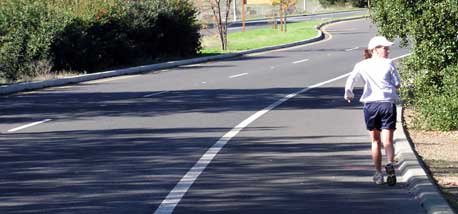
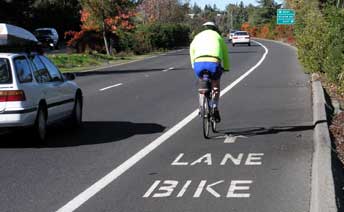
Walker on Foothill (above) is subject to a $149 fine if ticketed by police. Bicyclists were also fined, between 1966 and 1980.
Notice the positions of the walker and the bicyclist (above), which are typical for using shoulders and bike lanes. Walkers walk adjacent to the edge of pavement,
while bicyclists ride closer to the shoulder line --for less broken glass and better visibility.
A bicyclist passing a walker acts no differently than if passing a slower bicyclist, or a stopped bicyclist. There is no conflict
[details at bottom**].
[Photo locations are Foothill Expressway: (first photo) near Page Mill Road, approaching name change to Junipero Serra Boulevard;
(second photo) approaching Hillview Ave, looking NW; (below) approaching Page Mill Rd, looking NW; taken in Nov. 2004]
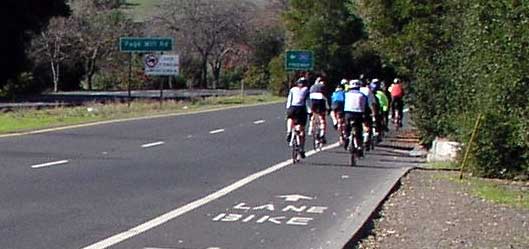
After the repeal of bicycle prohibitions on Foothill, the signs were changed from "bicycles prohibited" to "bike lane" and the word "bike lane" was painted on shoulder that the highway engineers had falsely claimed to be "unsafe" for bicycles. This means bicyclists were "prohibited" from using this "bike lane" for years! The Vehicle Code allows walking in a bike lane where an adjacent sidewalk is lacking.
Page Mill Road is 50 mph while Foothill Expressway is 45 mph. Otherwise, both are very similar. Yet, the one with the lower speed limit has the pedestrian prohibitions. "Expressway" arterial roads have no higher speeds than many other arterial roads, yet are "express" --faster-- because they have fewer stops (fewer signal lights), not because of higher speed limits. This is also true for "express" buses, which observe the same speed limits as local buses. Fewer intersections not only decreases travel time, it also adds to safety of walkers and bicyclists because most accidents occur at intersections.
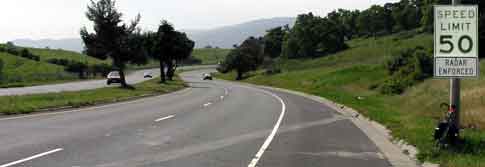
Junipero Serra Boulevard and Foothill Expressway are actually the same road, called County Road G-5. Pedestrians (and previously, bicycles) are banned from the best facilities, the wide (8-foot) shoulders of Foothill Expressway (top section), but not the narrower shoulder (by 2 feet) of Junipero Serra Boulevard (below).
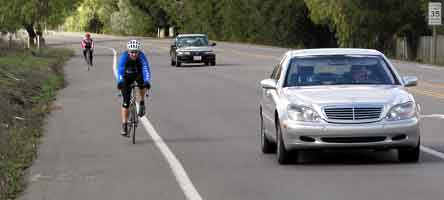
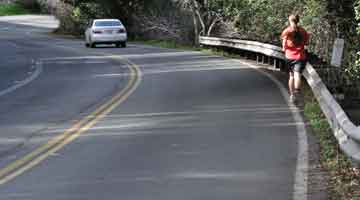
Most walkers on Foothill are actually crossing it, at intersections. Very few people walk along Foothill, but those who do have these reasons:
Shoulders, not sidewalks, are the usual pedestrian facilities of State Highways in suburban areas of most towns. Below examples all have speed limits of 45 mph, the same as most "expressway" roads in this County. In large metro areas such as this County, State Highways tend to be freeways, so shoulder use is less common. However, local examples are Hwy 82 (Monterey Road in San Jose and El Camino in Atherton) and Hwy 9, not to mention many arterial roads of cities [see City of Santa Clara photos], and most "expressway" arterial roads.
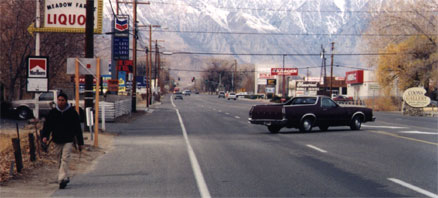
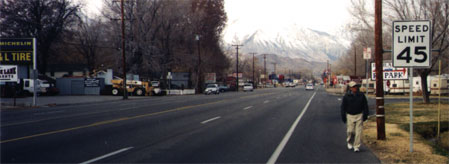
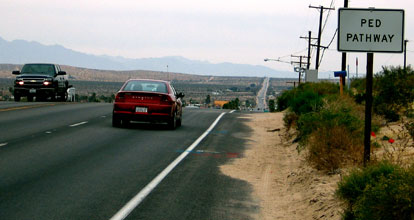
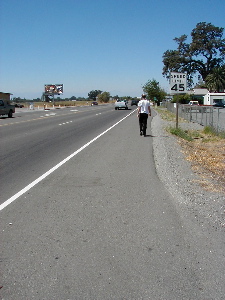
Left: Town of Joshua Tree (Hwy 62) with sign on shoulder stating "PED PATHWAY".
Right: Red Bluff (Hwy 99).
Highway 84 has no shoulders at all, is very windy and steep, but still allows walkers and bicyclists. Frankly, unless someone proposes prohibiting using Highway 84, it would not make sense to propose prohibiting using the 8-foot shoulders on Foothill. In fact, in the 1970s, I [Akos Szoboszlay] often bicycled on Highway 84. To get there from San Jose, I was "prohibited" from bicycling on the shoulders of Foothill -- the safest road of my entire trip! I had to either make huge detours or risk ticketing by police, depending how much time I had.
Links to pedestrian safety on expressways.
See why the prohibitory signs themselves increase
danger to bicycles and pedestrians and how the VTA BPAC voted.
The VTA BPAC voted again when the highway engineers, again, tried to impose new prohibitions.
Analyses of Pedestrians along Expressways
Why were pedestrians and bicycles originally prohibited?
Compare with Montague Expressway:
Walkers have always been allowed, but are subject to appalling conditions (on portions in San Jose and Milpitas).
For historical information on the fight against
bicycle use of shoulders / bike lanes of expressways (until 1991) and against electric trains and streetcars in the Bay Area, click
Conflict of Transportation Competitors ![]() .
.
Palo Alto City Ordinance 10.32.050: Pedestrians prohibited - Foothill Expressway.
(a)No person, other than peace officers acting in the performance of their duties or authorized maintenance or construction personnel, shall, except in designated crosswalks, walk upon or drive any livestock upon the Foothill Expressway at any location on said expressway between Page Mill Road and the southerly city limits at Adobe Creek.
(b)Notwithstanding the provisions of subsection (a) hereinabove, the driver and passengers of a disabled vehicle stopped on Foothill Expressway at any location between Page Mill Road and the southerly city limits at Adobe Creek may walk to the nearest exit, in either direction, on that side of the expressway upon which the vehicle is disabled, from which telephone or auto repair services are available.
(Ord 2844 § 1, 1975)
**No bike-ped conflict: On paths or sidewalks, the pedestrians normally walk in the center and sometimes make sudden random movements. In contrast, on shoulders of roads, they walk in a straight line, adjacent to either the curb or the edge of pavement (whichever exists). If there is a gutter pan, they walk in that. This is easily verified by observing pedestrians on shoulders of not only expressways, but State highways of Caltrans in suburban areas (see above photos).